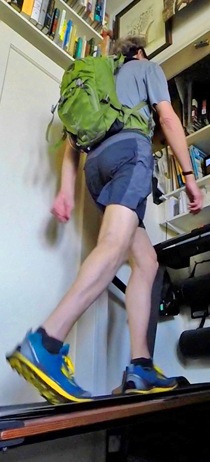October 14, 2022. Burn more calories than you eat: that’s the trick for all my Walks That Ate Everywhere from New York to Paris to Beijing to Omaha. Net calorie deficits from wonderful all-day walking tours punctuated by great food stops. Or all-day eating tours interrupted by walks. However you want to think about it.
If you really want to lose weight – and keep it off – your best bet really is walking. At a moderately brisk pace. Every day – not just the occasional adventure or sightseeing tour. Here’s how and why:
Exhibit A: a study of “Biggest Loser” contestants published in the journal, Obesity.
Let’s start with the “reality show” contestants who lost colossal amounts of weight in a few months of intensive daily exercise and harsh dieting. The follow-up study showed that almost all of them gained back almost all the weight they’d lost – and some gained more than they’d lost. So they were dramatic examples of what most “dieters” experience. The key to understanding what happened is “resting metabolism”: the rate at which you burn calories when you’re at rest.
It’s well known that crash dieting results in a significantly lowered resting metabolism. So when you stop or ease up on your calorie deprivation and vigorous exercising, you’re burning fewer calories during all those hours you’re not exercising. So you start gaining weight. To avoid this, you’d have to compensate with many hours of exercise. Most of the Biggest Losers didn’t, and a few years later they were back where they started. Or bigger. Despite the fact that most of them continued to eat less than they had before their TV stardom. The lesson: eating better alone doesn’t keep weight off. You have to exercise, too. But how?
Exhibit B: the recent study by the London School of Economics (LSE). The folks at LSE wanted to know because they wanted to determine the most effective and cost-effective way to combat the obesity epidemic. And reduce the one billion pounds (sterling) spent each year by the National Health Service to achieve weight loss in the generally overweight British population. Specifically, they wanted to be specific about the best way to exercise moderately 30 minutes each day for at least five days per week.
The winner: moderately brisk walking. Better than a variety of moderate-intensity exercises at the gym, better than swimming, cycling, football, tennis, weight-lifting and sit-ups. And the list goes on.
Better at reducing Waist Circumference and Body Mass Index. They “found that men and women who regularly walked briskly for more than 30 minutes had lower BMIs and smaller waists than those who engaged in regular sports/exercise.”
How fast is “brisk”?
Turns out this is a big, important question for everyone who walks for exercise. I always thought “brisk” must be about 3 miles per hour or faster – because that’s a pace that’s a little faster than casual-social-window-shopping walking for most people. And that’s the pace I use when I do the math to tell you that 25 minutes of brisk walking burns all 134 calories in a serving of that luscious Portobello Mousse. So I thought you’d want to know about this study that provides a very specific definition of “brisk”.
Public Library of Science published this report, “The Relationship of Walking Intensity to Total and Cause-Specific Mortality”. Here’s the conclusion: “The risk for mortality: 1) decreases in association with walking intensity, and 2) increases substantially in association for walking pace >24 minute mile (equivalent to <400m during a six-minute walk test) even among subjects who exercise regularly.“
Translation: if it takes you more than 24 minutes to walk a mile (that’s a speed of less than 2.5 mph), your cardiovascular exercise benefit is relatively small. If you walk faster, the benefits are significantly greater.
How much faster? Doesn’t seem to matter much. The study subjects who walked a moderately brisk 3 mph, a very brisk 3.75 mph and a race-walking 4.5 mph all benefitted similarly in terms of reduction in risk for premature death, cardiovascular disease, diabetes and dementia. Compared to the slower-walking group, their “all causes” risk was 44% lower. And much lower for dementia.
So if you can pick up the pace a bit, there’s a real benefit. But if you can’t – don’t. There’s still a huge benefit from walking at any pace compared to doing nothing. You still burn calories, for example; it just takes a little longer. In fact, if you feel you can’t pick up the pace beyond 2.5 mph, this new study suggests you see your doctor for a thorough checkup. You may have a cardiovascular or other problem that limits your walking pace. And if you’re over 70, this study may not apply to you: the subjects were mostly 40 – 65.
So get out there and walk. Anywhere.
Or walk in place. Anyplace. You can do it in a closet, but you’ll be happier if you come out. Into a room with your smartphone, tablet or TV that becomes your window onto spectacular trails in the most beautiful places. By Way of Treadmill Trails, the App.
You don’t even need a treadmill. Walk in place like this.
Walking – it’s Better for Waist Reduction. It’s Cheaper – you already know how to do it and all you need is a good pair of shoes. But don’t do it too much Slower: in this case, Brisk is Better.
Every Thing Is Everything
“Walking is the best possible exercise. The object of walking is to relax the mind. You should therefore not permit yourself even to think while you walk. But divert your attention by [appreciating] the objects surrounding you. Habituate yourself to walk very far.”
– Thomas Jefferson
It’s Always Something
“It does not matter how slowly you go so long as you do not stop.” – Confucius
I guess he was speaking metaphorically, not medically.

